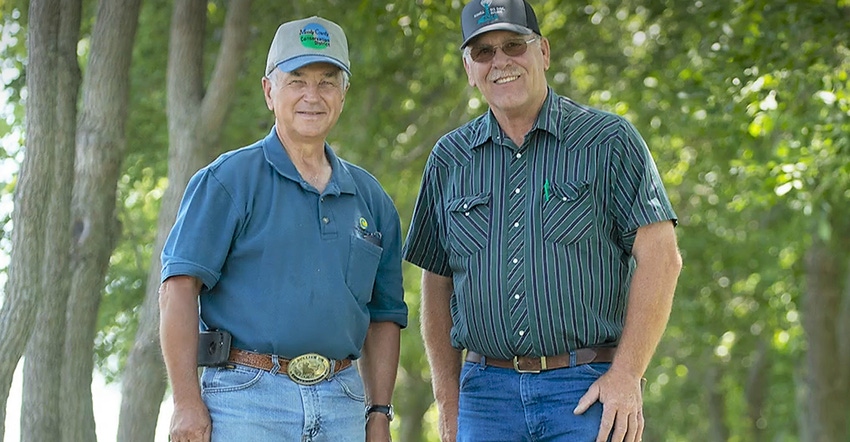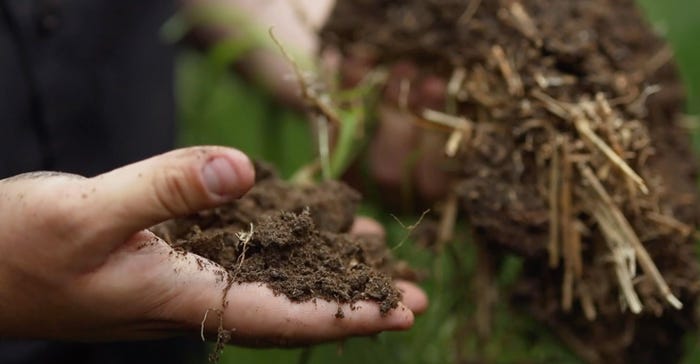February 5, 2021

Editor’s note: This is the second in a series of seven stories about landowner-tenant relationships in achieving soil health goals more quickly and efficiently together.
Non-operator landowner Jack Majeres’ journey into soil health didn’t happen overnight. It was gradual. In Majeres’ case, it started a long time ago, when he was a youngster on the Moody County family farm in South Dakota he has been renting to Larry Hauglid.
As Majeres and Hauglid talked about their owner-tenant relationship and how it evolved into regenerating the soils, three things stood out — ethics, empathy and expense.
Lifetime of conservation influence
Some people develop a conservation ethic later in life, others grow up with it. If your parents live and breathe conservation as you’re growing up, whether you actively farm the land later in life or not, you’re likely to carry that conservation ethic with you. Put Majeres in that camp.
He was born and raised on the Moody County farm his father, an avid conservationist, cared for so well it received South Dakota’s top conservation farm award more than 50 years ago when Majeres was young and impressionable.
“It’s something that was passed on to me,” he says. Influenced by his father, Majeres would graduate from South Dakota State University and go to work as district manager for the Minnehaha County Conservation District in 1974. Seven years later, he switched to work full-time for the South Dakota Air National Guard.
But he loved farm life, and in 1984, Majeres purchased the 156-acre family farm from his folks. He moved his wife, Alice, and their children back home and became the fourth-generation of Majereses on the farm.
While he had stopped working for pay in the conservation office, he soon began to volunteer as a conservation district supervisor; he’s done so for more than 35 years, at the local, state, and national level. Over the years, Majeres kept close tabs on new conservation practices and soil-building techniques.
Walk conservation walk
“With that size farm it was hard to justify buying the equipment to farm it myself,” Majeres says, “plus my work at the Air National Guard would have me deployed about the time I needed to be home doing something on the farm. So instead of losing the farm, I decided to cash rent it.”
With his conservation ethic reinforced by six years of experience working for the conservation district, Majeres knew the value of crop rotations and insisted the annual rental contract call for a four-crop rotation, with oats or small grains incorporated with alfalfa, corn and soybeans.
But he recognized the varying returns from different crops, and to be fair, Majeres proposed to his tenant, Larry Hauglid, that cash rental rates would be adjusted to fit the particular crop that was being grown on a particular field each year. “Jack was more than willing to work with cash rent and that’s really helped us on our side,” Hauglid says.

Majeres was also patient. “We were conventional operators and between Jack and myself it took several years to slowly switch over to no-till,” Hauglid says. “In that transition, our yields actually went down, just because it takes time to transition; him being willing to work with cash rent really helped us be able to invest in a no-till drill and do things like that to make it work. We slowly worked into it and it’s worked out fine for us.” In fact, Hauglid says, his crop yields increased with less fertilizer input in just a few years.
Share expense of conservation
Landowners who recognize soil health practices lead to higher productivity and profitability for themselves long-term can make faster progress by sharing costs of soil building practices with their renter.
“The one thing that landowners should do is become more aware of what is happening on their farms,” Majeres says. He’s been monitoring soil organic matter levels, a key indicator of soil productivity, for several years and has seen a gradual improvement. “I’ve been pleasantly surprised. My organic matter is running right at 5%. Everybody tells me that’s a good number, but my goal is to get to 7% or 8%,” he says.
Majeres says the “living soil” he sees on his farm is a concept that needs to be pursued by all agricultural owners as well as producers. “You’re not only protecting the soil and building it back up again for future generations to use to raise their food, you’re improving the environment by pulling more carbon out of the air, reducing soil erosion, and reducing the amount of fertilizer inputs needed,” he says.
Cover crops are a key practice to all those benefits, but there is a cost for seed and planting ― a cost Majeres thinks needs to be shared. “The producer is out there year after year to try to make ends meet, and we need to be cognizant of that effort and share in the profits as well as the challenges that come along. I cost-share the investment in cover crops each year with Larry 50-50, so that reduces his cash rental rates. I’m benefiting from it and he is benefiting from it — he doesn’t need to stand the entire cost of implementing that cover crop,” Majeres says.
The fact that Hauglid has a cow herd gives both men another way to benefit. “With my livestock operation we were able to use the alfalfa and the small grain portion of it, and we can sometimes graze the cover crops and corn stalks in the fall,” Hauglid says.
The grazing saves money by not having to pay someone to haul and spread manure if the cows had been confined to a lot, and the manure improves Majeres’ land. “Scientists tell us that cattle traffic is beneficial to healthy soils, not only by depositing their manure but also their hoof traffic helps soil organisms,” Majeres says.
To hear their story, visit South Dakota Non Operator Landowner.
Betts writes from Johnston, Iowa.
About the Author(s)
You May Also Like




